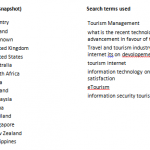 Emma Crowley and David Ball, Student and Academic Services, discuss open access publishing, and the role of the institutional repository BURO, and launch a short staff survey on open access publishing…
Emma Crowley and David Ball, Student and Academic Services, discuss open access publishing, and the role of the institutional repository BURO, and launch a short staff survey on open access publishing…
- What do you understand by Open Access?
- Do you deposit your research outputs in BURO, BU’s online repository?
- Who owns the copyright to your research papers?
- Would you consider publishing in an Open Access Journal?
At BU these are exciting times for research and one of the key ways of ensuring that your work has impact is to make it available Open Access. Most of you will be familiar with BURO, our online research repository, and are hopefully contributing your research outputs on a regular basis as per BU’s Academic Publications Policy. As a strategic part of your personal research processes it is essential that you retain your own pre-print (pre peer review) and post-print (post peer review) copies of your journal articles as most publishers will allow you to make either of these formats available open access, but not the branded publisher PDF. You can check copyright permissions in BURO using the Sherpa Romeo tool.
So, how do we know how impactful our research really is? The answer to this challenging question, discussed at length at this week’s Developing and Assessing Impact for the REF Conference, is not necessarily here, but clearly research that is being viewed and downloaded by large numbers of global web users has a greater chance of influencing policy and attracting more citations. Below are the 3 most downloaded full text journal articles in BURO during the last quarter. You can even see which search terms people are using to find your work.
Buhalis, D. and Law, R., 2008. Progress in information technology and tourism management: 20 years on and 10 years after the Internet – The state of eTourism research. Tourism Management, 29 (4), pp. 609-623. 517 Downloads
Edwards, J. and Hartwell, H., 2006. Hospital food service: a comparative analysis of systems and introducing the ‘Steamplicity’ concept. Journal of Human Nutrition and Dietetics, 19 (6), pp. 421-430. 506 Downloads
van Teijlingen, E. and Hundley, V., 2001. The Importance of Pilot Studies. Social Research Update (35), pp. 1-4. 405 Downloads
In addition to BURO BU recently launched its own Open Access Publication Fund that will support BU academics in publishing their research in Open Access journals, where a fee is required to publish, but everyone can view your article.
We would be very grateful if you could participate in a short survey, the results of which will help inform BU strategy on Open Access and wider developments for Open Access in UK HE. There is only one page of questions which will take you less than 10 minutes to complete. The survey will remain open until Monday 30th June.
Please note: if you experience any technical difficulties using the survey please contact Learning Technology
 Open Access Highlights from BURO – August 2014
Open Access Highlights from BURO – August 2014










 Further CMWH contributions to 2026 ICM congress
Further CMWH contributions to 2026 ICM congress New PhD publication on Nepal’s migrant workers
New PhD publication on Nepal’s migrant workers Six BU contributions 2025 Festival of Social Sciences
Six BU contributions 2025 Festival of Social Sciences ECR Funding Open Call: Research Culture & Community Grant – Apply Now
ECR Funding Open Call: Research Culture & Community Grant – Apply Now MSCA Postdoctoral Fellowships 2025 Call
MSCA Postdoctoral Fellowships 2025 Call ERC Advanced Grant 2025 Webinar
ERC Advanced Grant 2025 Webinar Horizon Europe Work Programme 2025 Published
Horizon Europe Work Programme 2025 Published Horizon Europe 2025 Work Programme pre-Published
Horizon Europe 2025 Work Programme pre-Published Update on UKRO services
Update on UKRO services European research project exploring use of ‘virtual twins’ to better manage metabolic associated fatty liver disease
European research project exploring use of ‘virtual twins’ to better manage metabolic associated fatty liver disease
Open access publishing versus traditional academic journal articles
I have mixed feelings about Open Access publishing. I have published in many Open Access journals, but equally in many traditional journals. These mixed feelings are also reflected in my membership of editorial or advisory boards of Open Access journals such as BMC Pregnancy & Childbirth (www.biomedcentral.com/bmcpregnancychildbirth/), The Open Nursing Journal (www.bentham.org/open/tonursj) and the Kathmandu University Medical Journal (kumj.com.np/home.php?page=homepage&fd=1) as well as traditional academic journals such as Midwifery (http://www.elsevier.com/wps/find/journaldescription.cws_home/623060/description ).
Yes, Open Access offers free, immediate, permanent online access to the full text of research articles for anyone, anywhere in the world. The latter is particularly important since my colleagues and I do a lot of research in Nepal, where access to traditional academic journals is often poor (and expensive). But submitting to Open Access journal can be expensive, for example, at the moment BMC Pregnancy and Childbirth asks authors or their institutions to pay for each article a processing charge of £1,175.
In stead of expensive subscription charges for academic journals universities end up paying a submission charge per Open Access article. The cost of providing the academic literature to the wider world needs to be paid for by the university, either in the form of journal subscriptions through the library (and online access) or on publication as a submission charge.
One of the journals mentioned above, the Kathmandu University Medical Journal does not ask for payment on submission. The website seems to operate on advertising on its web pages, but there are limitations in this model too. First, the journal is struggling a little and secondly, do we want to run the risk of business needs (not upsetting the advertisers) conflicting with the need to publish papers critical of the services, drugs, medical instuments, etc. sold by the advertiser?
Prof. Edwin van Teijlingen